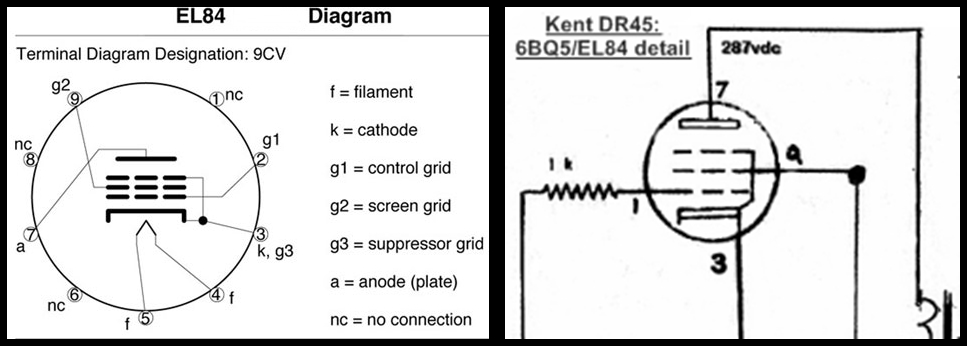Your Cart is Empty
NOW FREE SHIPPING TO 48 CONTIGUOUS UNITED STATES ON ALL ORDERS!!!
When Working on EL84/6BQ5 Tube Amps, You MUST know This about Pins One and Two!
by vaughn skow May 31, 2017 2 min read
Okay Gang, take a close look at these two side-by-side pics. Do ya see the problem here? On the left is the current pin designation for a EL84/6BQ5 output tube; what's connected to pin one? Nothing! Now, to the left is a detailed look at the way the EL84/6BQ5 tubes are wired on the vintage Kent amp I just had on the bench (read my last blog). What??? Why are they sending the signal to PIN ONE of those tubes??!! Don't they know that pin one goes to ... nothing?? Well ... let's talk about that!

The thing is, up until somewhere in the early 1980's EL84/6BQ5 tubes had pins one and two INTERNALLY TIED ... they BOTH went to grid one! That was the original spec given to that model when it was birthed in 1949. Why did manufacturers STOP including the internal tie between 1 &2? Shoot, it seems nobody knows ... but it DID happen. Personally, I believe it was a result of the "free world" ceasing to manufacture vacuum tubes in the 1980s and all production moving to Soviet block countries and China. Ever read those crazy owners manuals that accompany electronic devices manufactured and sold direct from China? Stuff like "We glad purchase you our quality device. It provide service many years excellence ..." Yes, stuff really does get "lost in translation"! And I feel that's the case with these tubes. I can see the Soviets or Chinese scratching their heads and saying "Crazy Americans! Why they attach two pins to same grid? That CRAZY, we not do that!"
And that brings us to WHY did they do it anyway, right? Well ... the thought was that it helped keep space between pins and minimize construction issues and make the tube sockets less congested and easier to work on (remember, electronic stuff was BIGGER then). So what happens when you put a "modern" EL84 in an amp wired with the input going to pin one, as in the case of this Kent? NOTHING, that's what. To put it plainly, the signal stops there. The easy solution is to just move the grid feed over to pin two, or as I did, just jumper pins 1 & 2 on the socket. But, what about if the problem expresses itself the OTHER way around? What if a modern amp builder is unaware of the internal connection between pins 1 and 2 on vintage tubes and they use pin 1 on the socket as a tie point for the screen grid resistor? Needless to say, this doesn't end well for NOS tubes used in those amps. If you are designing amps with EL84 power sections ... don't be that guy! NOS EL84/6BQ5 sets cost a pretty penny these days. Nuff said.
Leave a comment
Comments will be approved before showing up.
